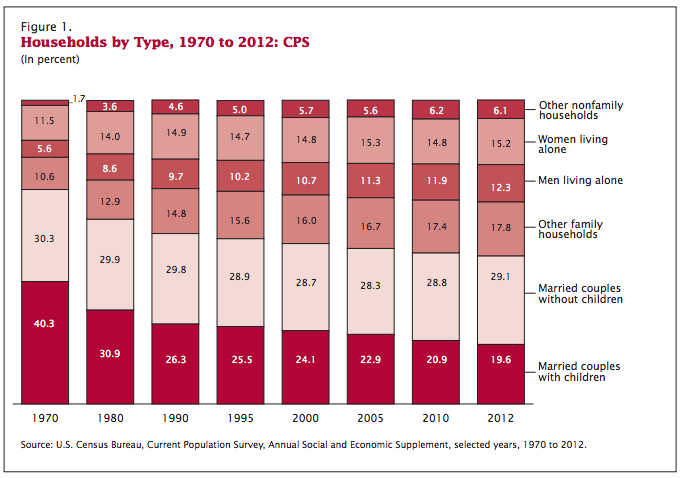The Changing Face of the American Household
Trends/Issues
October 2013 -- A new report from the U.S. Census Bureau provides an updated picture of the composition and complexity of American families and households, as well as trends in living arrangements.
The report notes that over the last few decades the trend in the U.S has been toward smaller households, fewer family and married-couple households, and more people living alone, especially at older ages.
Key findings examining data from last 4 decades (1970-2012):
-
“Nuclear families” (married, with children under age 18 living in the household) accounted for just 19.6% of U.S. households in 2012, down from 40.3% in 1970.
-
Married couples made up most (63%) of the family groups with children under the age of 18.
-
Living alone has become more widespread; the proportion of one-person households increased from 17% to 27% in the past four decades.
-
The increase in living alone and the decline in married households reflect a rising age at first marriage for men and women
-
Two-thirds (66%) of households in 2012 were family households, down from 81% in 1970.
-
The report notes that changes in households by type have been small in more recent decades--the biggest changes occurred between 1970 and 1980.

-
Since 1970, the average number of people per household declined from 3.1 to 2.6.
-
The most profound changes in household size occurred among the largest and smallest households. Households with five or more people decreased by half, from 21% to 10% of households, between 1970 and 2012 while the share of households with only one or two people increased from 46% to 61%. The report notes that changes in more recent decades have been small.
-
Nearly three-quarters (72%) of men aged 65 and over lived with their spouse compared with less than half (45%) of women.
-
Although married families tend to be economically better off than other families, the economic well-being of all family types worsened on average during the 2007–2009 recession and in the years since its official end.
-
During the latest recession, homeownership among households with their own children under the age of 18 fell by 15%. These households saw a 33% increase in parental unemployment.
Note: A household contains one or more people; a family household has two or more related people (birth, marriage, adoption); a nonfamily household can be either a person living alone or a householder sharing the unit with non-relatives (roommates, boarders).
About: The data in this Census Bureau report are from the Annual Social and Economic Supplement (ASEC) to the 2012 Current Population Survey (CPS) and the 2011 American Community Survey (ACS).
Source: U.S. Census Bureau, America’s Families and Living Arrangements: 2012, August 2013.





